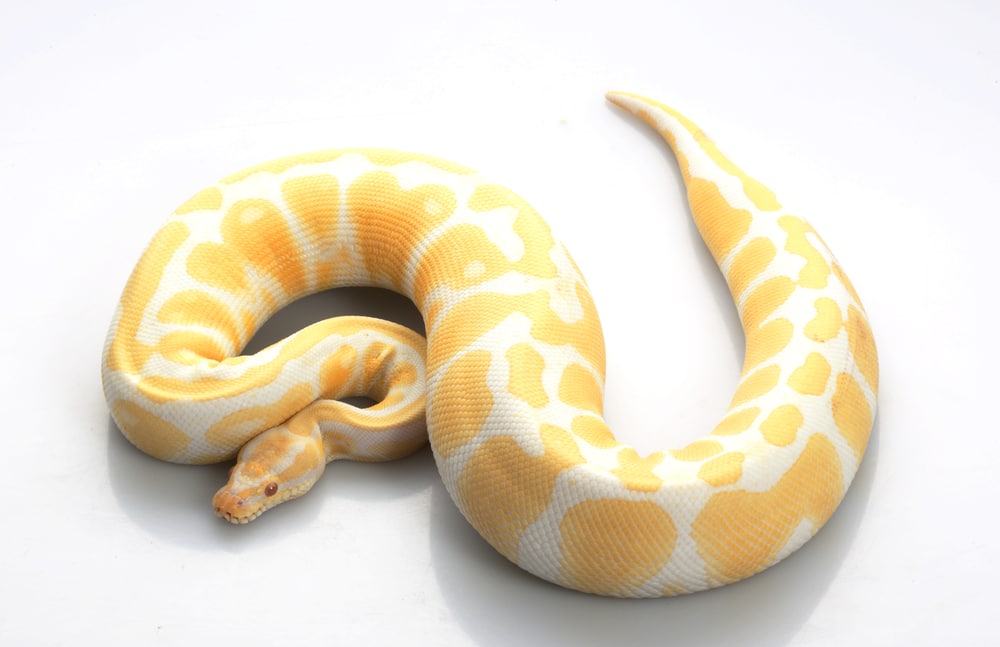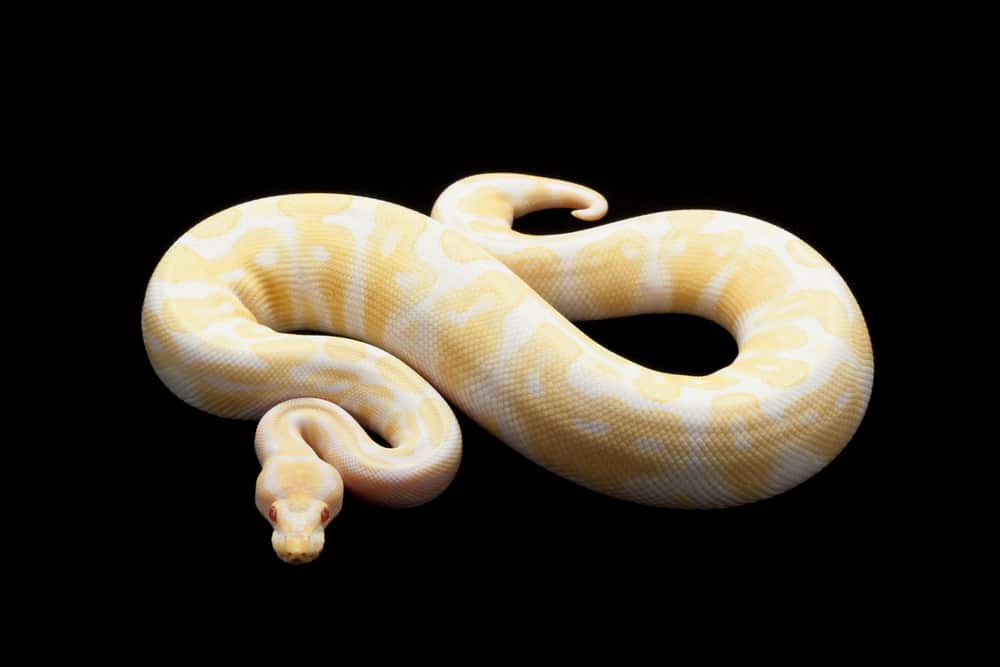In 1992 Ball Pythons were cheap, readily available and popular first snakes for beginner hobbyists. Most of these balls were imported. Some had interesting patterns or nice colors, but they did not command a premium on the market.
That year Bob Clark introduced the first albino ball pythons to the market. Years earlier, Clark purchased an albino ball female found in Africa. Albino ball pythons are very rare in the wild. Their coloration makes them stand out in their environment, so most die before they mature.

Wild caught female ball pythons are notoriously difficult to breed in captivity. It was years before Bob Clark’s albino female delivered a clutch. Clark was then able to breed the offspring to produce the first captive bred Albino balls.
Before 1992 serious snake collectors showed little interest in ball pythons. The arrival of Bob Clark’s Albinos changed the market. Ball python breeders became interested in collecting atypical ball pythons and breeding them to produce “morphs.”
Bob Clark’s Albinos cost $7,500 apiece. Within a few years particularly valuable morphs were selling for over $25,000. Many snake breeders added ball python morphs to their collection. New snake breeders bought morphs to cash in on the lucrative ball python market.
Some ball python morphs still command high prices. Albino balls have become much less expensive. But Albino ball pythons are still beautiful. If you don’t have thousands of dollars to spend on the latest morph, an albino ball can still be a worthwhile, and cheaper, part of your life.
This article will tell you more about the Albino ball python morph, so you can decide if an Albino ball is a good fit for your collection.
Quick Navigation
Albino Ball Python Morph Appearance
Some morphs are subtle. Albinos are impossible to miss. Their white skin and red eyes stand out in any environment. Both predators and snake keepers find Albino balls irresistible.
Where a normal ball python is brown, an Albino ball python is snowy white. Unlike other morphs, Albino balls will not darken with age. Their pupils are unpigmented: the blood vessels in an Albino ball’s retina color their eyes a bright garnet-red.
Caramel Albinos and Banana ball pythons produce much less melanin than a normal ball. Albino balls produce no melanin at all. Their patterns are bright canary yellow. As the Albino ball grows older they may fade to a soft yellowish-cream.
Once you get past their albinism, Albino balls look and behave very much like normal ball pythons. Their bright coloration makes them easy prey in the wild and makes hunting for food challenging. When provided with food and protected from predators, an Albino ball is no more difficult to raise than any other ball python.

Genetics
Albinism is a congenital disorder which affects pigmentation and coloration. It may manifest as hypomelanism, a reduced production of melanin, or as amelanism, a complete lack of melanin production.
Albinism is caused by an absence or shortage of tyrosinase (tyrosine 3-monooxegenase). Tyrosinase is an enzyme required for melanin production. Caramel Albinos and Banana balls are hypomelanistic. Albino ball pythons are amelanistic. Snake breeders often distinguish between these forms of albinism as T+ (tyrosinase-positive) and T- (tyrosinase negative).
Albinism is found throughout the plant and animal kingdoms. In the wild albinism is a disadvantage.
Plants
- Albino plants produce little or no chlorophyll.
- Amelanistic albino seedlings cannot benefit from photosynthesis and die quickly
- Hypomelanistic albino plants may survive but will usually be stunted.
Animals
- Albino animals are more visible to predators and prey.
- Albinism is often associated with vision and hearing problems which will make hunting more difficult.
- Albinos have no protection from UV radiation and are prone to sunburn and skin cancers.
But before you get too concerned about your Albino ball python’s health, remember that many albino animals lead long healthy lives in the wild.
- Albino bison were honored by Great Plains Indians.
- Pinky, an albino bottlenose dolphin, has become a Louisiana tourist attraction and has been spotted with her albino calf.
- Mocha Dick, an ill-tempered albino sperm whale, destroyed over 20 whaling ships, escaped 80 others, and inspired Herman Melville to write Moby Dick.
Pattern of Inheritance
Albinism is a recessive gene. Both parents must carry the gene and the zygote must receive a copy from each. If an Albino ball python mates with a normal ball, the offspring will all look like normal ball pythons. But each will carry one copy of the Albino mutation.
If a “het Albino” ball python mates with an Albino, half the clutch will be Albino and the other half “het Albino.” But when two het Albino balls mate, things become more complicated. That clutch will consist of:
- 25% Albino
- 50% Het Albino
- 25% Normal
If a het Albino mates with a normal ball, half the clutch will be het Albino and half normal balls. But since there are no visual differences between normal and het Albino ball pythons, there is no way of telling which is which!
Breeders describe these clutches by the chance each normal-looking ball has of being het Albino.
- Albino + normal: 100% het Albino
- 100% het Albino + 100% het Albino: 66% het Albino
- 100% het Albino + normal: 50% het Albino
(Please note that the actual number of normal and morph offspring can vary with each clutch. Over a greater number of breedings the percentages will move toward the mean. But any given pairing can produce a disproportionate number of morph or normal babies.)
Albino Ball Python Issues
Pet Albino ball pythons are protected from many of the issues which endanger wild albinos. They have a steady supply of food and do not need to hunt. The cage which keeps them in also keeps predators out. And they don’t have to worry about sunburn. Once those variables are taken out of the equation, Albino balls are no more difficult to keep than a normal ball python.
Popular Albino Ball Python Combinations
There are many popular Albino combinations. Some work better than others. Color morphs rely on pigment production. Albino Ghosts or Albino Bananas are almost indistinguishable from any other Albino. But pattern morphs combined with albino coloration can be spectacular.
Albino x Black Pastel: The Albino Black Pastel has a darker-hued and more sharply defined pattern. And if you breed your Albino Black Pastel to another Albino 50% of your clutch will be Albino Black Pastels.
Albino x Candy (Candino): The Candino adds an overlay of lilac to the Albino’s white background. The Candy and Albino genes are allelic (variant expressions of the same gene), so an Albino x Candy cross produces 100% Candinos.
Albino x Clown: The Clown’s blotchy pattern and wide dorsal stripe is especially striking when combined with Albino coloration. The interplay of white and yellow looks like a lava lamp or an abstract painting.
Albino x Enchi: Albino Enchis have dark yellow, clearly defined patterns on a pale peach yellow background. Yellow is the only pigment Albino balls produce, and the Enchi morph takes full advantage of it.
Albino x Genetic Stripe: The Albino Genetic Stripe is a pale yellow snake with a thick white stripe down its spine. They are more difficult to produce, since they are a double recessive combination. But when you see an Albino Genetic Stripe you will think the effort worthwhile.
Albino x Piebald: While the pattern on Albinos is generally canary yellow, on Albino Piebalds it is often a darker shade of yellow or orange. This makes a gorgeous contrast to the patches of pure white. This is one of the most popular, and memorable, Albino designer morphs.
Albino x Pinstripe: Largely yellow or orange with sharply defined white lines, Albino Pinstripes resemble Albino Spiders but do not suffer from the Spider’s infamous neurological problems.
Albino x Spider: Spiders have thin black lines over a brown background. Albino Spiders have thin white lines on a yellow background. But watch out for the headshaking and balance issues known as “Spider Wobble.”
Albino x Super Black Pastel: If you breed two Albino Black Pastels, together 25% of the clutch will be patternless gunmetal-lilac tinted Albino Super Black Pastels, or “Blizzard balls.” They are lovely, but sometimes suffer from skull deformations called “duckbills.”
Albino x Toffee (Toffino): The Toffee and Candy mutations are closely related to each other and are both alleles of the Albino gene. The Toffino looks very like the Candino but with a pale ecru replacing the pale mauve.
There are also some impressive Albino triple and quadruple combinations, including:
- Albino Black Pastel Spider Pinstripe (Albino Black Spinner)
- Candino Cinnamon Pastel (Candino Pewter)
- Albino Lesser Mahogany
- Albino Lesser Pastel Spider (Albino Queen Bee)
- Albino Pastel Pinstripe (Albino Kingpin)
- Candino Lemon Pastel Pinstripe (Candino Blast)
Albino Ball Python Care
For the most part, Albino ball pythons are no more difficult to raise than a normal ball python. Give them adequate space, a comfortable hiding place, fresh water and a temperature gradient between 75° and 95°.
Because they are more sensitive to light than normal ball pythons, you should keep your Albino ball’s habitat away from direct sunlight. Strong light is dazzling to Albino eyes and will make them uncomfortable. 8-10 hours of darkness a day will help your Albino ball get adequate rest.
Ball pythons hunt by heat pits and smell, so their poor eyesight will not keep Albino balls from feeding. It is still best to feed Albino balls, and ball pythons in general, with frozen/thawed food rather than live prey. A cornered rat can injure or even kill a snake.
If you have a fussy ball which turns up its snout at frozen food, you should stun or kill the prey before feeding. Many owners will hesitate at doing this. You can also try scenting thawed rats with chicken broth before feeding.
Many fussy ball pythons are actually refusing food because of stress. If your Albino ball is refusing to eat, give them some quiet time. A towel over their cage can provide privacy and smaller prey items may prove more appealing than larger ones. And if your Albino Ball’s stress is making you stressed, remember that snakes often go months without food in the wild.
Conclusion
Albino ball pythons are beautiful, easy to keep and relatively inexpensive. Take your time to find a reputable dealer. Snakes from the best breeders cost you a bit more, but the money you spend now will save you heartache, time and veterinary bills in the future.
Do your research before buying. Groups like BP Forums and Fauna Classifieds Ball Pythons Forum will put you in touch with other ball python lovers. They will be able to offer experienced advice on any questions you may have.
Do you have an Albino ball python? What advice would you give somebody thinking about adding an Albino to their collection? Do you have any pointers, stories or photos you would like to share? Let us know your thoughts in the comments below!